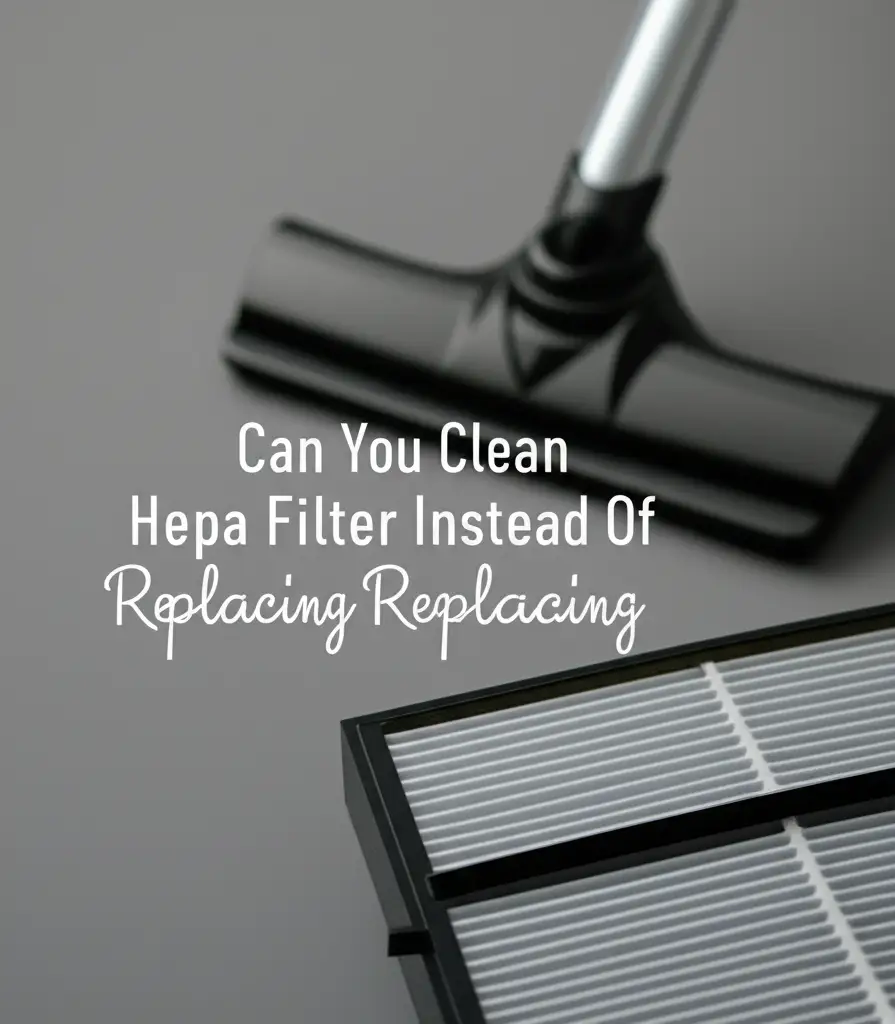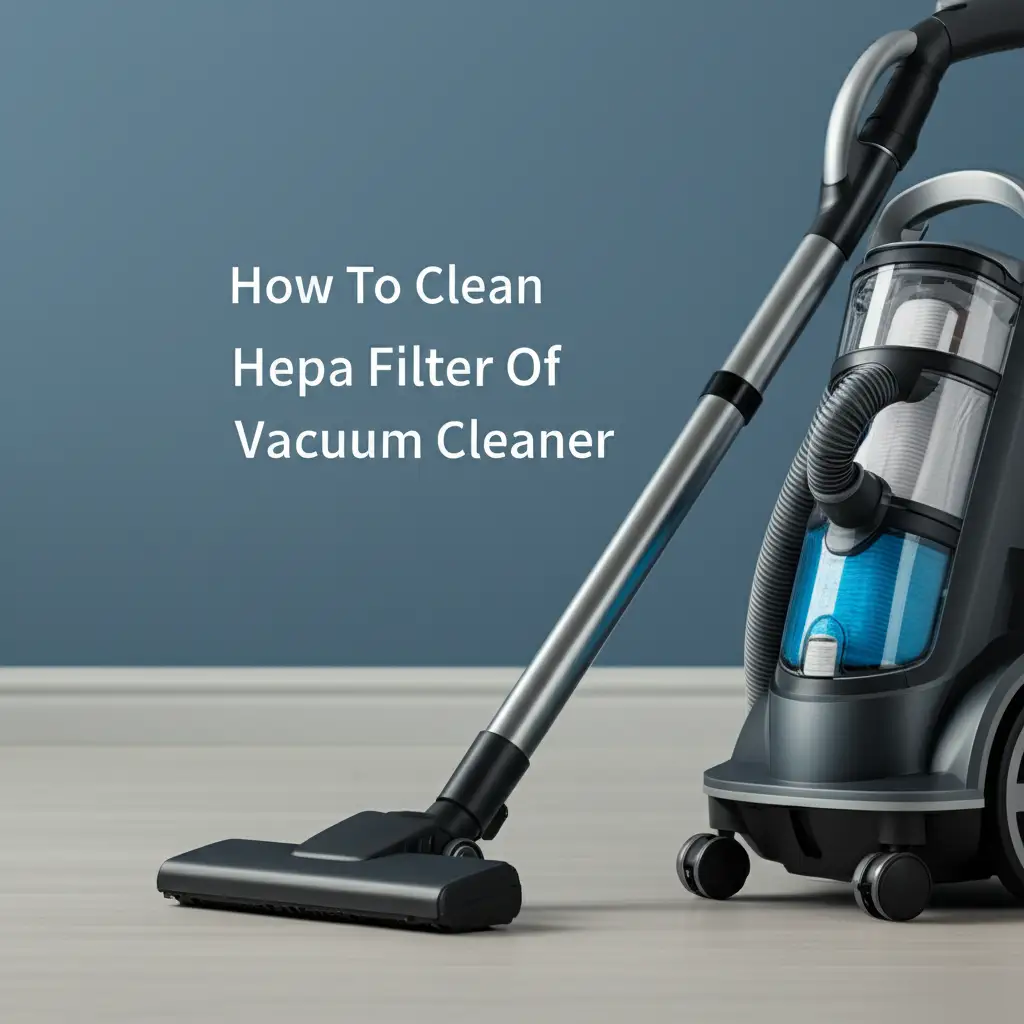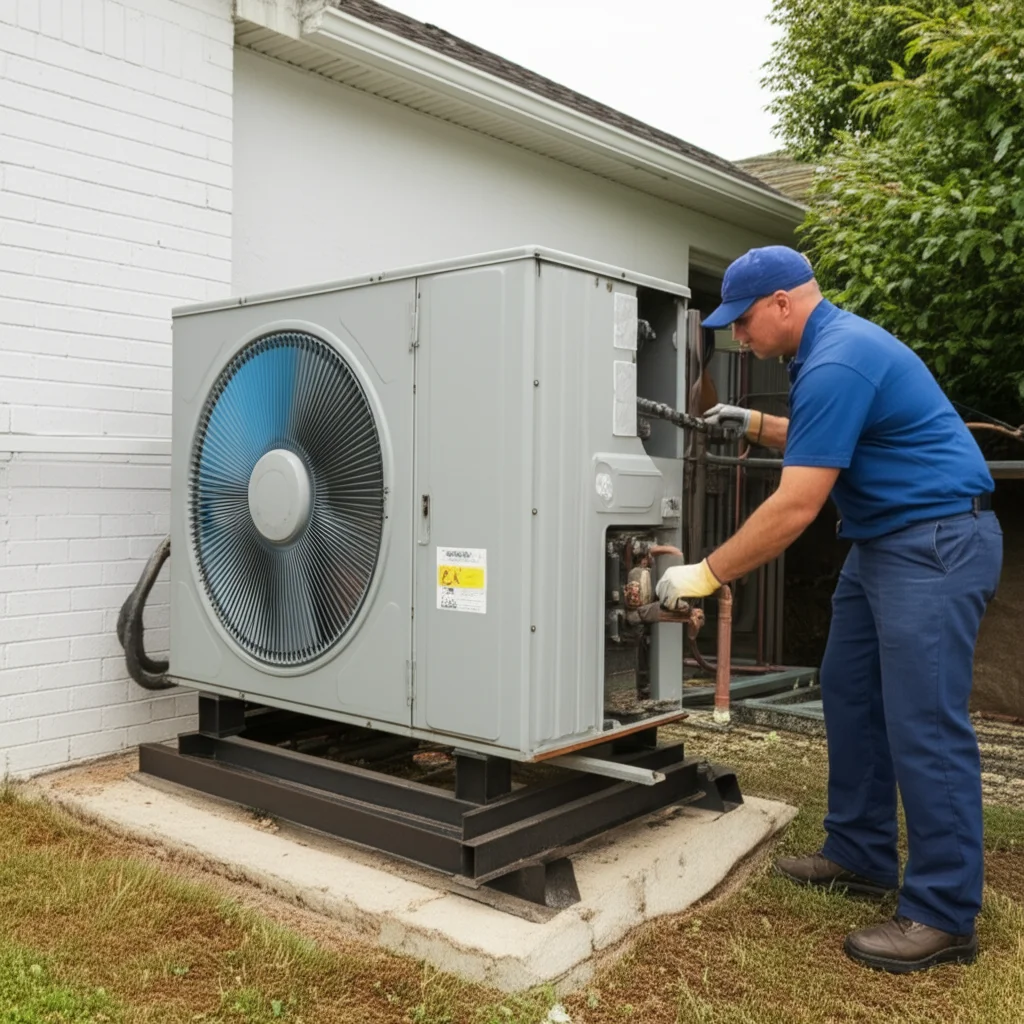· Kianna Connelly · Home Maintenance · 14 min read
Can You Clean Hepa Filter Instead Of Replacing

Can You Clean Hepa Filter Instead Of Replacing?
A dirty HEPA filter can make your air quality worse. Many people wonder if they can clean a HEPA filter instead of replacing it. This question comes up often. It is important to know the right answer. Replacing filters costs money. Cleaning them seems like a good solution.
This article explores whether cleaning a HEPA filter is possible. We will explain the different types of HEPA filters. You will learn which ones you can clean. We also provide steps for proper cleaning. We will cover when you must replace a filter. Understanding your filter helps you save money and keep your home air clean.
Takeaway:
- Identify Filter Type: Some HEPA filters are washable; others are not. Check your filter label or manual.
- Clean Washable Filters Properly: Use only water for cleaning washable HEPA filters. Allow them to dry completely.
- Never Wash Disposable Filters: Washing disposable HEPA filters destroys their structure and effectiveness.
- Replace When Necessary: Even washable filters need replacement over time. Look for signs like reduced airflow or odors.
Can You Clean a HEPA Filter Instead of Replacing It?
Yes, you can clean some HEPA filters instead of replacing them. This is true only for “washable” or “permanent” HEPA filters. Most HEPA filters are disposable. Disposable HEPA filters cannot be cleaned. Attempting to wash them will ruin their filtration ability. Always check your appliance manual or the filter label to confirm its type.
Understanding What HEPA Filters Are and How They Work
HEPA stands for High-Efficiency Particulate Air. A HEPA filter captures very small particles from the air. These particles include dust, pollen, pet dander, and mold spores. A true HEPA filter captures 99.97% of particles that are 0.3 microns in size. This makes HEPA filters essential for good indoor air quality.
The filter itself consists of a dense mat of randomly arranged fibers. These fibers are typically made of fiberglass. Air flows through this intricate web of fibers. Particles become trapped within this network. They are captured through three main mechanisms: impaction, interception, and diffusion. Impaction happens when larger particles hit the fibers directly. Interception occurs when particles follow the airflow path but touch a fiber. Diffusion traps the smallest particles, which move erratically and collide with fibers.
This unique structure allows HEPA filters to be highly effective. It also makes them delicate. The fibers are very fine. They are packed tightly together. This density is what allows them to catch tiny airborne contaminants. A HEPA filter’s job is to remove these tiny particles from your breathing air. It keeps your home environment healthier.
Over time, these trapped particles build up. This accumulation clogs the filter. A clogged filter reduces airflow. It also loses its effectiveness. When a filter gets too dirty, air cannot pass through it easily. This means your air purifier or vacuum cleaner has to work harder. This can lead to reduced performance and higher energy consumption.
Identifying Your HEPA Filter: Washable vs. Non-Washable Types
Knowing your HEPA filter type is critical. Not all HEPA filters are the same. Some are designed for washing, while others are not. Trying to clean a non-washable filter will destroy it. Always check your filter’s label or your appliance manual first.
Washable HEPA filters are often labeled as such. You might see terms like “washable,” “permanent,” or “cleanable.” These filters are constructed differently from disposable ones. Their materials and binding agents are designed to withstand water exposure. They usually have a sturdier frame or a different fiber composition. Many manufacturers include specific cleaning instructions for these filters. These instructions tell you how to clean the filter correctly. They also specify how often you should clean it. For more details on washing, see our guide on Can I wash the HEPA filter on my air purifier?.
Disposable HEPA filters are far more common. They are not meant to get wet. Their filtration media is typically made from a paper-like material. Water damages this delicate structure. It can cause the fibers to break apart. It can also cause mold to grow inside the filter. Washing a disposable HEPA filter severely reduces its efficiency. It can even release trapped particles back into the air. These filters are designed for simple replacement. Once they are dirty, you throw them away and insert a new one. Labels for these filters usually say “do not wash” or “replace every X months.”
Manufacturers clearly mark their filters. Look for a symbol indicating “do not wash” or a simple instruction to replace. If there are no washing instructions, assume it is disposable. Always follow the manufacturer’s guidelines. Ignoring these instructions leads to filter damage. It also harms your appliance. Incorrect cleaning can even void your warranty.
The Right Way to Clean Washable HEPA Filters
If you have a washable HEPA filter, cleaning it can extend its life. Cleaning is not complicated, but it requires care. The goal is to remove trapped dust without damaging the filter fibers. Improper cleaning can still ruin a washable filter. Always follow these steps carefully.
First, remove the filter from your appliance. Most air purifiers and vacuum cleaners have easy-to-access filter compartments. Handle the filter gently to avoid bending or tearing the media. You may see a lot of visible dust and debris. This is normal.
Next, take the filter to a sink or outdoor area. Use cool, running water to rinse the filter. Start rinsing from the clean side. This pushes the dirt out from the dirty side. Continue rinsing until the water runs clear. Do not use soap or cleaning agents. Detergents can damage the filter material. They can also leave residues that affect performance. Do not use high-pressure water. A gentle flow is all you need. For more detailed instructions on general HEPA filter cleaning, check out our article on How to Clean HEPA Filter. If you own a specific brand like Shark, you can find tailored advice on How to Clean Shark HEPA Filter.
After rinsing, the most critical step is drying. The filter must be completely dry before reinstallation. Water left in the filter can promote mold and mildew growth. This can release spores into your air. It also reduces the filter’s effectiveness. Shake off excess water gently. Then, place the filter in a well-ventilated area. Avoid direct sunlight or high heat. These can warp the filter frame or damage the media. Drying can take 24 to 48 hours. Some larger filters might need even longer. Make sure it is bone dry. Do not use a hairdryer or oven to speed up drying. Patience is key for this step. Once dry, your filter is ready for use again.
Why Cleaning Disposable HEPA Filters is Not Recommended
Many people wonder if they can clean their disposable HEPA filters. The simple answer is no. Attempting to clean a disposable HEPA filter is a mistake. These filters are not designed for washing. Their construction makes them unsuitable for any liquid cleaning method.
Disposable HEPA filters are typically made of very fine, fragile paper-like fibers. These fibers are tightly packed together. They form a dense mesh. This mesh traps microscopic particles. When water touches these fibers, they become saturated. This causes the fibers to clump together. It can also cause them to break apart. The delicate structure that makes them effective is destroyed. Once the fibers are damaged, the filter cannot capture particles efficiently. It loses its ability to filter the air.
Furthermore, washing a disposable filter can lead to other problems. Trapped dust and allergens become wet. They can form a sludge. This sludge can block the filter pores even more. This reduces airflow significantly. A wet filter also creates an ideal environment for mold and bacteria. These microorganisms can grow rapidly inside the damp filter. When you use the filter again, it releases mold spores and bacteria into your home. This can be worse for your health than the original dust.
Any attempt to dry a washed disposable filter will not restore its function. The damage is permanent. The filter media will be compromised. Its filtration capacity will be greatly reduced. This means your air purifier or vacuum will not clean the air effectively. Instead of saving money, you will end up needing a new filter anyway. You might also risk damaging your appliance due to poor airflow. Always replace disposable HEPA filters according to manufacturer recommendations. This ensures optimal performance and air quality.
Extending HEPA Filter Lifespan Through Proper Maintenance
You can extend the life of your HEPA filter, whether it’s washable or disposable. Proper maintenance goes beyond just cleaning or replacing. It involves caring for your entire filtration system. This care helps your HEPA filter last longer and perform better.
One simple step is to clean the pre-filter regularly. Many air purifiers and vacuum cleaners have a pre-filter. This pre-filter catches larger particles like hair and lint. It prevents these larger particles from reaching the HEPA filter. Pre-filters are often washable or easily vacuumed. Cleaning them frequently reduces the load on your HEPA filter. This means your HEPA filter stays cleaner for longer. For example, knowing if a carbon filter goes before or after a HEPA filter can help you understand the entire filtration system better.
Another good practice is to vacuum the outer surface of your HEPA filter. Use a soft brush attachment on your vacuum cleaner. Gently brush off loose dust and debris. Do this for both washable and disposable filters. This is not a deep clean, but it removes superficial buildup. This improves airflow and maintains performance. Be very careful not to damage the filter media. Do not press hard or use harsh tools.
Your home environment also affects filter lifespan. If you live in a very dusty area, your filters will get dirty faster. If you have pets, pet dander can clog filters quickly. Running your air purifier on a lower setting for longer periods might also extend filter life compared to running it on high settings sporadically. High settings pull more air, meaning more particles, which can fill the filter faster. Regular dusting and vacuuming in your home also reduce the overall airborne particle load. This lessens the work your HEPA filter has to do. By keeping your home clean, you help your filters stay clean.
Clear Signs It’s Time for HEPA Filter Replacement
Even with proper cleaning for washable filters, all HEPA filters eventually need replacement. Filters have a finite lifespan. They lose effectiveness over time. Knowing when to replace your filter is important for maintaining good air quality.
One common sign is reduced airflow. Your air purifier might feel like it is not moving as much air. Your vacuum cleaner might have less suction power. This happens when the filter becomes too clogged. The dense accumulation of particles blocks the passage of air. You might notice your appliance working harder or making more noise. This is a clear indicator that the filter is full.
Another tell-tale sign is a persistent, stale odor. HEPA filters trap airborne particles, but they do not typically remove odors. However, if a filter is very old or has trapped mold spores, it can start to produce an unpleasant smell. This smell might be musty or sour. If you notice a strange odor coming from your air purifier, it is a strong sign that the filter needs changing. This is particularly true if your filter does not have an activated carbon layer for odor absorption.
Visible damage to the filter media also means it is time for a new one. Look for tears, holes, or frayed areas. If the pleats are crushed or misshapen, the filter is compromised. Even if a filter is washable, repeated cleaning can eventually cause wear and tear. A damaged filter cannot capture particles effectively. It allows unfiltered air to pass through. Understanding how filters work, like knowing why HEPA filter size is 0.3 micron, emphasizes the importance of an intact filter.
Finally, always follow the manufacturer’s replacement recommendations. Most manufacturers suggest a replacement schedule. This might be every 6 to 12 months for air purifiers. It could be less frequent for vacuums. Your appliance might even have a filter indicator light. This light tells you when the filter is nearing the end of its life. Do not ignore these warnings. Replacing your filter on time ensures your appliance performs optimally. It keeps your indoor air clean and healthy.
Benefits of Smart HEPA Filter Management: Cost, Health, and Environment
Managing your HEPA filters wisely offers multiple benefits. It saves money, protects your health, and helps the environment. It involves a balanced approach: cleaning when possible and replacing when necessary. This smart management prevents unnecessary expenses and keeps your home air quality high.
From an economic perspective, cleaning washable HEPA filters saves significant money. Replacement filters can be expensive. Many households have multiple appliances using HEPA filters. The cost of replacing filters annually adds up quickly. By extending the life of washable filters through proper cleaning, you reduce these recurring expenses. This is a tangible saving for your budget. Even for disposable filters, regular pre-filter cleaning can extend their life slightly. This also offers some cost savings.
Health benefits are paramount. A well-maintained HEPA filter ensures clean indoor air. It effectively removes allergens, pollutants, and other harmful particles. This reduces triggers for asthma and allergies. It also prevents respiratory issues. A clogged or damaged filter cannot do its job properly. It allows dirty air to recirculate. Smart management ensures your filter always performs at its best. This protects your family’s well-being. Knowing when to clean and when to replace maintains peak filtration efficiency.
Environmentally, responsible filter management reduces waste. Disposable HEPA filters contribute to landfills. Each filter thrown away adds to the waste problem. Extending the life of washable filters means fewer filters enter the waste stream. Choosing washable options where possible is a greener choice. Even for disposable filters, maximizing their lifespan before disposal helps. This approach aligns with sustainable living practices. It reduces your household’s environmental footprint. By thinking about how you handle your HEPA filters, you make a positive impact on your wallet, your health, and the planet.
FAQ Section
Can all HEPA filters be cleaned?
No, not all HEPA filters can be cleaned. Only “washable” or “permanent” HEPA filters are designed for cleaning. Most HEPA filters are disposable. Disposable filters are made of delicate material that water will damage. Always check your filter’s label or your appliance manual.
How often should I clean a washable HEPA filter?
The cleaning frequency for washable HEPA filters depends on usage. It also depends on your environment. Generally, clean them every 2-4 weeks for light to moderate use. For heavier use, such as in dusty homes or with pets, clean them more often. Always let the filter dry completely before reinstallation.
What happens if I try to wash a non-washable HEPA filter?
Washing a non-washable HEPA filter will destroy its filtration capabilities. The delicate fibers will clump, break, or grow mold. This makes the filter ineffective. It can also release trapped pollutants back into the air. You will need to replace the damaged filter immediately.
How do I know if my HEPA filter is washable?
Check the filter’s frame or the appliance manual. Washable HEPA filters are usually labeled “washable,” “permanent,” or “cleanable.” They often have specific cleaning instructions. If there are no washing instructions, or it says “replace,” assume it is disposable.
Does cleaning a HEPA filter reduce its effectiveness?
Cleaning a washable HEPA filter properly does not reduce its effectiveness in the short term. It restores its airflow and particle-trapping ability. However, repeated washing over many years can cause wear. This means even washable filters eventually need replacement. Washing a disposable filter immediately reduces its effectiveness.
How long do HEPA filters last?
The lifespan of a HEPA filter varies. Disposable filters typically last 6-12 months. Washable filters can last 2-5 years or more. This depends on usage, air quality, and maintenance. Always follow the manufacturer’s recommendations for replacement. Look for signs of reduced performance, like diminished airflow.
Conclusion
Understanding your HEPA filter is key to maintaining clean air. You can clean HEPA filter if it is specifically labeled as washable or permanent. This practice saves money and reduces waste. Always use plain water and ensure complete drying for washable types. Never attempt to wash disposable HEPA filters; they will lose all effectiveness.
Proper maintenance, like cleaning pre-filters and general home cleanliness, also extends filter life. However, even washable HEPA filters have a finite lifespan. Pay attention to signs like reduced airflow, persistent odors, or visible damage. These indicate it is time for replacement. By following these guidelines, you ensure your air purification system performs optimally. This protects your indoor air quality and promotes a healthier living environment. Always prioritize your health and the efficiency of your home appliances.





